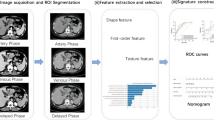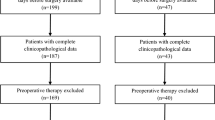Abstract
Purpose
To assess contrast-enhanced computed tomography (CE-CT) features for predicting malignant potential and Ki67 in small intestinal gastrointestinal stromal tumors (GISTs) and the correlation between them.
Methods
We retrospectively analyzed the pathological and imaging data for 123 patients (55 male/68 female, mean age: 57.2 years) with a histopathological diagnosis of small intestine GISTs who received CE-CT followed by curative surgery from May 2009 to August 2019. According to postoperatively pathological and immunohistochemical results, patients were categorized by malignant potential and the Ki67 index, respectively. CT features were analyzed to be associated with malignant potential or the Ki67 index using univariate analysis, logistic regression and receiver operating curve analysis. Then, we explored the correlation between the Ki67 index and malignant potential by using the Spearman rank correlation.
Results
Based on univariate and multivariate analysis, a predictive model of malignant potential of small intestine GISTs, consisting of tumor size (p < 0.001) and presence of necrosis (p = 0.033), was developed with the area under the receiver operating curve (AUC) of 0.965 (95% CI, 0.915–0.990; p < 0.001), with 91.53% sensitivity, 96.87% specificity, 96.43% PPV, 92.54% NPV, 94.31% diagnostic accuracy. For high Ki67 expression, a model made up of tumor size (p = 0.051), presence of ulceration (p = 0.054) and metastasis (p = 0.001) may be the best predictive combination with an AUC of 0.785 (95% CI, 0.702–0.854; p < 0.001), 63.33% sensitivity, 76.34% specificity, 46.34% PPV, 86.59% NPV, 73.17% diagnostic accuracy. Ki67 index showed a moderate positive correlation with mitotic count (r = 0.578, p < 0.001), a weak positive correlation with tumor size (r = 0.339, p < 0.001) and with risk stratification (r = 0.364, p < 0.001).
Conclusion
Features on CE-CT could preoperatively predict malignant potential and high Ki67 expression of small intestine GISTs, and Ki67 index may be a promising prognostic factor in predicting the prognosis of small intestine GISTs, independent of the risk stratification system.






Similar content being viewed by others
Data availability
All datasets generated for this study are included in the manuscript.
Abbreviations
- GIST:
-
Gastrointestinal stromal tumor
- CE-CT:
-
Contrast-enhanced computed tomography
- ROC:
-
Receiver operating characteristic
- C.I.:
-
Confidence interval
- AUC:
-
Area under the curve
References
Ren C, Wang S, Zhang S (2020) Development and validation of a nomogram based on CT images and 3D texture analysis for preoperative prediction of the malignant potential in gastrointestinal stromal tumors. Cancer Imaging. 20(1):5. https://doi.org/10.1186/s40644-019-0284-7
Lee SJ, Song KB, Lee YJ, et al. (2019) Clinicopathologic Characteristics and Optimal Surgical Treatment of Duodenal Gastrointestinal Stromal Tumor. J Gastrointest Surg. 23(2):270–279. https://doi.org/10.1007/s11605-018-3928-1
Joensuu H (2008) Risk stratification of patients diagnosed with gastrointestinal stromal tumor. Hum Pathol. 39(10):1411–1419. https://doi.org/10.1016/j.humpath.2008.06.025
Nishida T, Blay JY, Hirota S, Kitagawa Y, Kang YK (2016) The standard diagnosis, treatment, and follow-up of gastrointestinal stromal tumors based on guidelines. Gastric Cancer. 19(1):3–14. https://doi.org/10.1007/s10120-015-0526-8
Lin JX, Chen QF, Zheng CH, et al. (2017) Is 3-years duration of adjuvant imatinib mesylate treatment sufficient for patients with high-risk gastrointestinal stromal tumor? A study based on long-term follow-up. J Cancer Res Clin Oncol. 143(4):727–734. https://doi.org/10.1007/s00432-016-2334-x
Li J, Ye Y, Wang J, Zhang B, Qin S, Shi Y et al (2017) Chinese consensus guidelines for diagnosis and management of gastrointestinal stromal tumor. Chin J Cancer Res. 29(4):281-293. https://doi.org/10.21147/j.issn.1000-9604.2017.04.01
Yin Y, Liu C, Zhang B, Wen Y, Yin Y (2019) Association between CT imaging features and KIT mutations in small intestinal gastrointestinal stromal tumors. Scientific Reports. 9(1):7257. https://doi.org/10.1038/s41598-019-43659-9
Chen T, Xu L, Dong X, et al. (2019) The roles of CT and EUS in the preoperative evaluation of gastric gastrointestinal stromal tumors larger than 2 cm. Eur Radiol. 29(5):2481–2489. https://doi.org/10.1007/s00330-018-5945-6
Wei SC, Xu L, Li WH, et al. (2020) Risk stratification in GIST: shape quantification with CT is a predictive factor. Eur Radiol. 30(4):1856–1865. https://doi.org/10.1007/s00330-019-06561-6
Feng C, Lu F, Shen Y, et al. (2018) Tumor heterogeneity in gastrointestinal stromal tumors of the small bowel: volumetric CT texture analysis as a potential biomarker for risk stratification. Cancer Imaging. 18(1):46. https://doi.org/10.1186/s40644-018-0182-4
Kurata Y, Hayano K, Ohira G, et al. (2018) Fractal analysis of contrast-enhanced CT images for preoperative prediction of malignant potential of gastrointestinal stromal tumor. Abdom Radiol (NY). 43(10):2659–2664. https://doi.org/10.1007/s00261-018-1526-z
Su Q, Wang Q, Zhang H, et al. (2018) Computed tomography findings of small bowel gastrointestinal stromal tumors with different histologic risks of progression. Abdom Radiol (NY). 43(10):2651–2658. https://doi.org/10.1007/s00261-018-1511-6
Verde F, Hruban RH, Fishman EK (2017) Small Bowel Gastrointestinal Stromal Tumors: Multidetector Computed Tomography Enhancement Pattern and Risk of Progression. J Comput Assist Tomogr. 41(3):407–411. https://doi.org/10.1097/RCT.0000000000000526
Zhou Y, Hu W, Chen P, et al. (2017) Ki67 is a biological marker of malignant risk of gastrointestinal stromal tumors: A systematic review and meta-analysis. Medicine (Baltimore). 96(34): https://doi.org/10.1097/MD.0000000000007911
Li LT, Jiang G, Chen Q, Zheng JN (2015) Ki67 is a promising molecular target in the diagnosis of cancer (review). Mol Med Rep. 11(3):1566–1572. https://doi.org/10.3892/mmr.2014.2914
Li H, Ren G, Cai R, et al. (2018) A correlation research of Ki67 index, CT features, and risk stratification in gastrointestinal stromal tumor. Cancer Med. 7(9):4467–4474. https://doi.org/10.1002/cam4.1737
Zhao WY, Xu J, Wang M, et al. (2014) Prognostic value of Ki67 index in gastrointestinal stromal tumors. Int J Clin Exp Pathol. 7(5):2298–2304
Basilio-de-Oliveira RP, Pannain VL (2015) Prognostic angiogenic markers (endoglin, VEGF, CD31) and tumor cell proliferation (Ki67) for gastrointestinal stromal tumors. World J Gastroenterol. 21(22):6924–6930. https://doi.org/10.3748/wjg.v21.i22.6924
Cai PQ, Lv XF, Tian L, et al. (2015) CT Characterization of Duodenal Gastrointestinal Stromal Tumors. AJR Am J Roentgenol. 204(5):988–993. https://doi.org/10.2214/AJR.14.12870
Baheti AD, Shinagare AB, O’Neill AC, et al. (2015) MDCT and clinicopathological features of small bowel gastrointestinal stromal tumours in 102 patients: a single institute experience. Br J Radiol. 88(1053):20150085. https://doi.org/10.1259/bjr.20150085
Feng F, Wang F, Wang Q, et al. (2019) Clinicopathological Features and Prognosis of Gastrointestinal Stromal Tumor Located in the Jejunum and Ileum. Dig Surg. 36(2):153–157. https://doi.org/10.1159/000487147
Vasconcelos RN, Dolan SG, Barlow JM, et al. (2017) Impact of CT enterography on the diagnosis of small bowel gastrointestinal stromal tumors. Abdom Radiol (NY). 42(5):1365–1373. https://doi.org/10.1007/s00261-016-1033-z
Xing GS, Wang S, Sun YM, et al. (2015) Small Bowel Stromal Tumors: Different Clinicopathologic and Computed Tomography Features in Various Anatomic Sites. PLoS One. 10(12): https://doi.org/10.1371/journal.pone.0144277
Wang C, Li H, Jiaerken Y, et al. (2019) Building CT Radiomics-Based Models for Preoperatively Predicting Malignant Potential and Mitotic Count of Gastrointestinal Stromal Tumors. Transl Oncol. 12(9):1229–1236. https://doi.org/10.1016/j.tranon.2019.06.005
Yi M, Xia L, Zhou Y, et al. (2019) Prognostic value of tumor necrosis in gastrointestinal stromal tumor: A meta-analysis. Medicine (Baltimore). 98(17): https://doi.org/10.1097/MD.0000000000015338
Liu X, Qiu H, Zhang P, Feng X, Chen T, Li Y et al (2018) Ki-67 labeling index may be a promising indicator to identify “very high-risk” gastrointestinal stromal tumor: a multicenter retrospective study of 1022 patients. Hum Pathol. 74(17-24. https://doi.org/10.1016/j.humpath.2017.09.003
Zhang QW, Gao YJ, Zhang RY, et al. (2020) Personalized CT-based radiomics nomogram preoperative predicting Ki-67 expression in gastrointestinal stromal tumors: a multicenter development and validation cohort. Clin Transl Med. 9(1):12. https://doi.org/10.1186/s40169-020-0263-4
Belev B, Brcic I, Prejac J, et al. (2013) Role of Ki-67 as a prognostic factor in gastrointestinal stromal tumors. World J Gastroenterol. 19(4):523–527. https://doi.org/10.3748/wjg.v19.i4.523
Acknowledgements
The authors thank Feng-Bo Huang for his technical assistance from the Department of Pathology, the Second Affiliated Hospital, School of Medicine, Zhejiang University and Dr. San-Hua Fang for his help in virtual microscopy system from Core Facilities, School of Medicine, Zhejiang University.
Funding
This work was supported by grants from the construction of major disease diagnosis and treatment technology research center—gastric cancer [Grant Numbers 17-2018-%s-0077] and the Zhejiang Medical and Health Science and Technology Plan Project [Grant Numbers 2021KY839].
Author information
Authors and Affiliations
Contributions
Zhu MP collected clinical and imaging data and participated in its design and coordination, Ding QL participated in the data processing and drafted the manuscript, Xu JX participated in its design and collected imaging data, Jiang CY collected clinical and imaging data and participated in the data processing; Wang J conceived of the study and participated in its design; Wang C collected clinical and imaging data and participated in its coordination; Yu RS conceived of the study, participated in its design and applied for the grants. All authors read and approved the final manuscript.
Corresponding authors
Ethics declarations
Conflict of interest
The authors declare they have no financial interests.
Ethical approval
The Institutional Review Board of Second Affiliated Hospital, School of Medicine, Zhejiang University approved this retrospective study and waived the requirement for written informed consent due to its retrospective nature.
Additional information
Publisher's Note
Springer Nature remains neutral with regard to jurisdictional claims in published maps and institutional affiliations.
Rights and permissions
About this article
Cite this article
Zhu, MP., Ding, QL., Xu, JX. et al. Building contrast-enhanced CT-based models for preoperatively predicting malignant potential and Ki67 expression of small intestine gastrointestinal stromal tumors (GISTs). Abdom Radiol 47, 3161–3173 (2022). https://doi.org/10.1007/s00261-021-03040-9
Received:
Revised:
Accepted:
Published:
Issue Date:
DOI: https://doi.org/10.1007/s00261-021-03040-9




